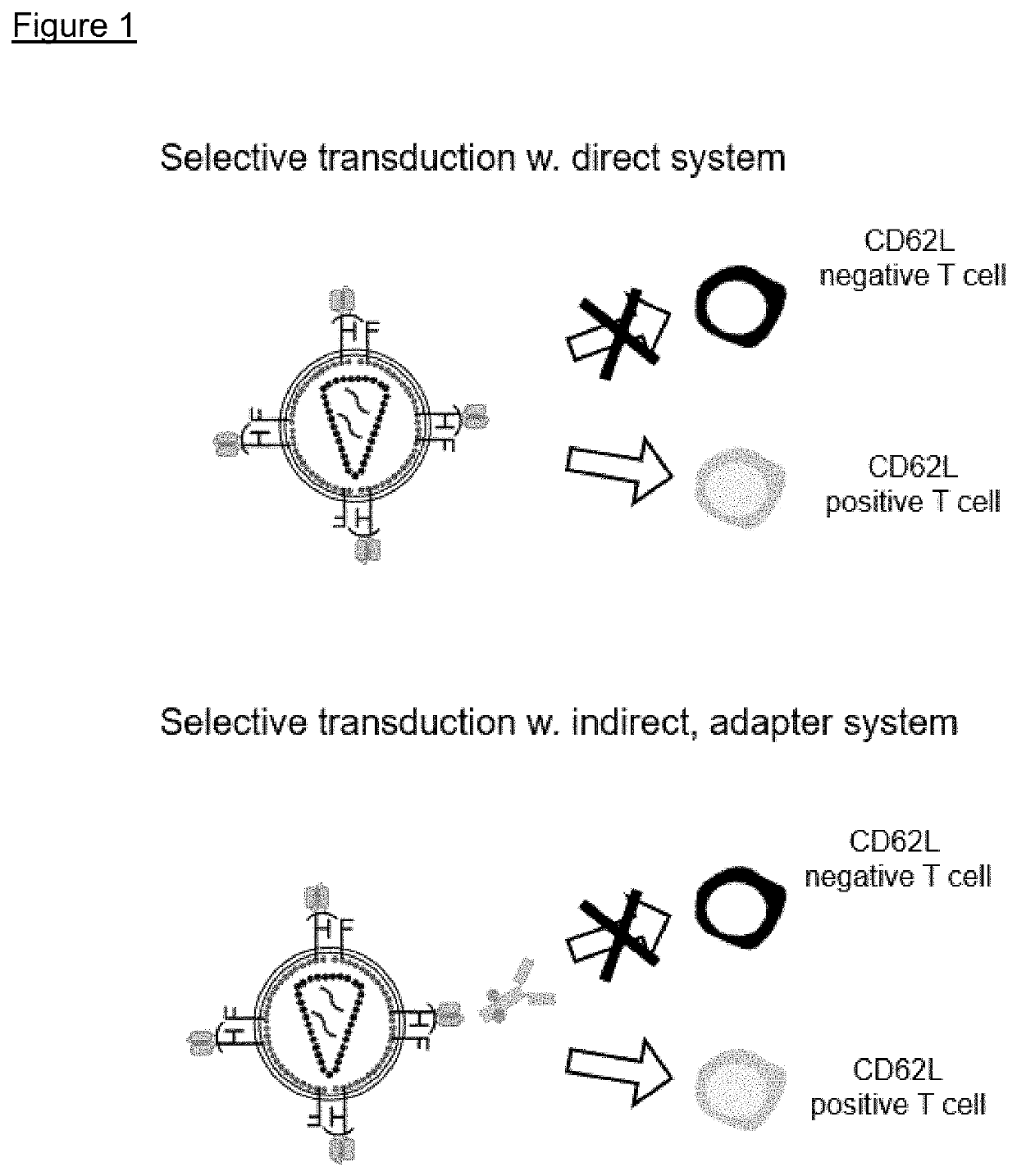CD62L specific lentiviral vector particle for targeted transduction of T cell subsets
a lentiviral vector and subset technology, applied in the direction of peptides, fusions for specific cell targeting, peptide sources, etc., can solve the problem of not being able to selectively transduce specific t cell subsets
- Summary
- Abstract
- Description
- Claims
- Application Information
AI Technical Summary
Benefits of technology
Problems solved by technology
Method used
Image
Examples
embodiments
[0077]In a preferred embodiment of the invention CD62L positive T cells are selectively transduced with a retroviral vector particle as disclosed herein in a mixed cell population containing CD62L positive and CD62L negative T cells.
[0078]The mixed cell population comprising T cells may be provided from a human e.g. patient suffering from cancer. CD4+ and / or CD8+ T cells may be enriched by a magnetic separation step using anti-CD4 and / or anti-CD8 antibodies or antigen binding fragments thereof coupled to a magnetic particle.
[0079]In a preferred embodiment the enriched CD4+ and / or CD8+ T cells are not activated with polyclonal activation reagents. In a preferred embodiment the enriched T cells have a naïve, central memory and / or stem cell memory phenotype. In another embodiment the genetically modified T cells were generated in equal or less than 72 hours, less than 48 hours, or less than 24 hours.
[0080]In another embodiment of the invention, the expansion of the genetically modified...
example 1
ion of CD62L Specific LVs
[0165]CD62L-specific pseudotyped lentiviral vectors (CD62L-LV) are generated by engineering envelope proteins that are used for pseudotyping. The two envelope proteins within the Paramyxoviridae family have distinct functions. The protein H, HN or G with antigen binding activity mediates binding to specific cellular receptor. Upon binding the protein with fusion activity mediates fusion of the viral and cellular membrane and entry of the viral capsid into the cytoplasm. A protein with antigen binding activity is rendered CD62L specific by reducing or ablating interaction with the native receptors and equipping it with a polypeptide such as a scFv, that is specific for CD62L. For lentiviral vectors that are pseudotyped with measles virus envelope proteins, the H protein is truncated at the cytoplasmatic domain and mutated at positions 481, 533, 548, 549 that are crucial for receptor binding. A polypeptide such as a CD62L specific scFv is added at the C-termin...
example 2
n of CD62L-LV
[0169]Pseudotyped retroviral vector particles specific for CD62L were generated by transient transfection of HEK-293T cells. HEK-293T cells that were seeded in T175 flasks in DMEM / 10% FBS the day before were transfected using PEI (Polyethyleneimine, branched 25 kDa, Sigma Aldrich) transfection with a composition of a plasmid encoding for the H protein, a plasmid encoding for the F protein, a packaging plasmid encoding gag / pol / rev and a psi-positive transfer vector plasmid encoding a polycistronic CD19-specific CAR cassette linked via F2A site to the LNGFR marker protein. A total of 35 μg DNA as a mixture of all aforementioned plasmids were diluted in 2.3 mL DMEM per T175 flask and vortexed for 20 sec. In parallel, per flask 140 μL of branched PEI (Sigma-Aldrich) was diluted in 2.2 mL DMEM and vortexed for 20 sec. The DNA containing solution and the PEI containing solution were combined, vortexed for 20 sec and incubated for 10 min at RT. The medium on HEK 293T cells was...
PUM
| Property | Measurement | Unit |
|---|---|---|
| diameter | aaaaa | aaaaa |
| volume | aaaaa | aaaaa |
| cell adhesion | aaaaa | aaaaa |
Abstract
Description
Claims
Application Information
 Login to View More
Login to View More - R&D
- Intellectual Property
- Life Sciences
- Materials
- Tech Scout
- Unparalleled Data Quality
- Higher Quality Content
- 60% Fewer Hallucinations
Browse by: Latest US Patents, China's latest patents, Technical Efficacy Thesaurus, Application Domain, Technology Topic, Popular Technical Reports.
© 2025 PatSnap. All rights reserved.Legal|Privacy policy|Modern Slavery Act Transparency Statement|Sitemap|About US| Contact US: help@patsnap.com



